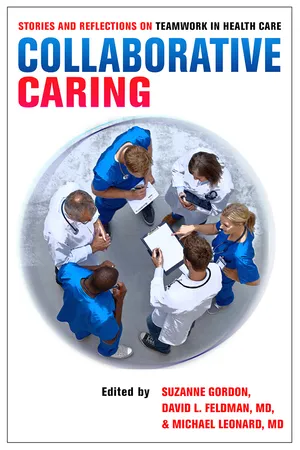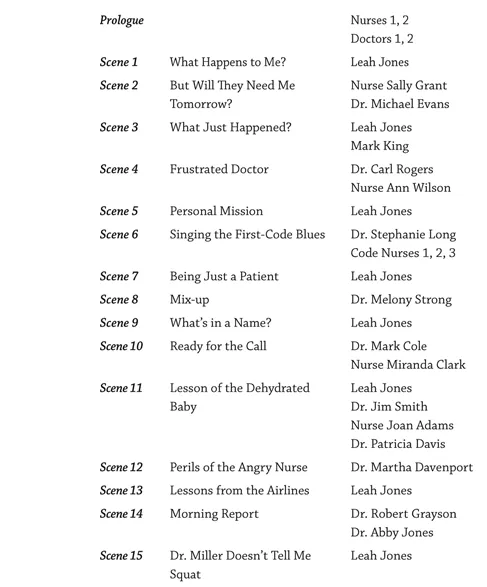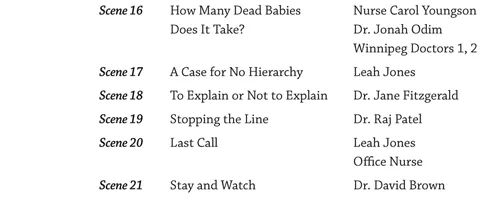![]()
PART 1
BEDSIDE MANNERS
The Play
CAST OF CHARACTERS
(in order of appearance)
Nurses 1, 2 and Doctors 1, 2: Of mixed ages and generations. Each actor plays several different nurses and doctors.
Leah Jones: Mid-to-late fifties. Narrator of the story, a wise observer of the health care system as a former nurse now experiencing the “other side of the stethoscope.”
Nurse Sally Grant: Early forties. Has been a nurse for twenty years, fifteen years on this medical-surgical (med-surg) unit. Has mastered the skill of communicating her medical assessment so that interns understand potential ramifications of decisions.
Dr. Michael Evans: Early thirties. Was an intern on med-surg unit. Has learned to listen to the nurses.
Mark King: Early thirties. Pharmacist irritated that nurses seem to think that they are the only ones who care about patients.
Dr. Carl Rogers: Mid thirties. Senior resident. Frustrated at not being able to convince a nurse to increase pain medication.
Nurse Ann Wilson: In her forties. Inflexible and unafraid to say “no” to doctors’ orders for increased pain medication.
Dr. Stephanie Long: Late forties. Recounts her experiences as an intern but is now a patient safety officer. Nurses help her get through first “code.” Good comic timing is important here.
Code Nurses 1, 2, 3: Help intern through her first “code.” (These roles can be combined into one if necessary.)
Dr. Melony Strong: Mid thirties. Tries to juggle too many patients.
Dr. Mark Cole: Mid forties. While on call, teaches new nurse even as he handles her middle-of-the-night phone call.
Nurse Miranda Clark: Early twenties. Very new nurse who is timid and nervous about calling a doctor in the middle of the night.
Dr. Jim Smith: Early thirties. He’s a resident in a pediatric ICU, where he had a run-in with a nurse about getting a line in a baby.
Nurse Joan Adams: In her thirties. Is worried about the condition of their tiny patient.
Dr. Patricia Davis: Late forties. Helps with dehydrated baby.
Dr. Martha Davenport: Early-to-mid thirties. Frustrated in dealing with a nurse’s “punishment.”
Dr. Robert Grayson: Early fifties. Is an attending at a major teaching hospital who thinks it’s important not to move on too quickly if there is something to be learned.
Dr. Abby Jones: Late twenties. Yells at nurse for screwing up blood draw that nurse had done correctly.
Nurse Carol Youngson: Early fifties. Chief OR nurse, tries to deal with new pediatric cardiac surgeon whose competence she questions.
Dr. Jonah Odim: Early thirties. New pediatric cardiac surgeon whose actions lead to the deaths of twelve babies.
Winnipeg Doctors 1, 2: Late forties or early fifties. Dismissive and condescending about nurses’ concerns about Dr. Jonah Odim.
Dr. Jane Fitzgerald: Late twenties. ER intern on night shift, frustrated with nurse’s refusal to get X-ray.
Dr. Raj Patel: Mid fifties. Chief of perioperative services, understands need to provide support to nurse who stops the line.
Office Nurse: Any age.
Dr. David Brown: Early fifties. Head of oncology division at teaching university, reflects on nurse who taught him to be a doctor.
LIST OF SCENES WITH CHARACTERS
ABOUT THE STAGING
The play is performed reader’s theater style, with actors reading from scripts at music stands facing the audience. The actor playing “Leah” should be at a music stand stage right, slightly apart from the others, because she is the narrator of the story. There are two other music stands—one is stage center and has a sign that says “MD” and the other is stage left with a sign that says “RN or Other Team Member.” When an actor is playing a doctor, he or she moves to the stand that says “MD.” When an actor is playing a nurse or other team member, he or she moves to the stand so labeled.
INTRODUCING THE
PERFORMANCE
The playwrights suggest that a brief introduction be given before the performance to set the context for both the play and the performance. The person introducing the play might say the following:
We welcome you to this performance of the play Bedside Manners. The play is based on actual interviews with doctors, nurses, and others in the health care field. While some scenes are composites of different incidents, everything in the play is based on actual workplace experiences. Some of the things you will see in the play occurred more than a decade ago. Some occurred just several months ago. Many similar encounters are taking place in health care institutions all over the globe while we sit here watching or discussing the play.
Although the play focuses primarily on physician-nurse relationships, it includes some encounters between other health care professionals. The encounters between physicians and nurses—whether problematic or promising—are emblematic of the communication and teamwork problems that occur in health care no matter what the professional or occupational category.
As you watch the play, we encourage you to make a mental note of any strong reactions to material in the play. We also encourage you to think about which scenes offer you a window into the experience and perceptions of others with whom you work or mirror your own experiences or perceptions.
Because you are watching a theatrical performance, we will repeat the instructions that you have often heard in other theaters. Please turn off any cell phones, pagers, smartphones, Ipads—or any electronic devices that have been developed in the last several hours. Please unwrap any candies or other food items that you may have brought with you so as not to distract the actors.
And now, Bedside Manners.
THE PLAY
Prologue
(Four actors enter and stand in a line downstage of the three music stands. They speak directly to the audience. Think of the Prologue as a series of musical phrases: “**” indicates the end of one phrase and the beginning of a new one. The “**” may also indicate that the actors become different characters.)
Nurse 1: The human body is absolutely incredible.
Doctor 1: Being a doctor—it’s all I ever wanted.
Nurse 2: Nursing—it’s all I ever wanted to do.
All: There’s nothing else like it.
**
Doctor 2: My advice? Make nice to the nurse so she won’t torture you to death. A nurse can make your life miserable by waking you up in the middle of the night just when you’ve grabbed your only five minutes of sleep. Or she can protect you, let you get your sleep, depending on how you treat her.
Nurse 1: One physician tells you to call him for any vital sign change; another says, “Don’t call me unless such and such happens.” You wake up a doc in the middle of the night and it’s not in the ballpark of what he wants to be woken up about, he can get very testy.
Doctor 1: A nurse calls me late one night to ask for Tylenol for a patient with arthritis pain. I order it. Three weeks later the patient dies. Complications of surgery. Nothing to do with the Tylenol, but I get sued, along with everyone else who ever touched the chart or spoke to a nurse about the guy. Every single thing I say or do has repercussions. The buck stops here.
Nurse 2: Doctors are always saying, “The buck stops here,” and in a way ...


